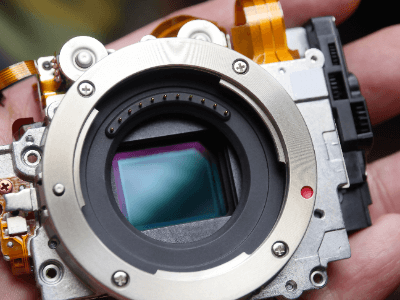What Is a CMOS Camera Module?
 A CMOS camera module is a camera equipped with a CMOS image sensor.
A CMOS camera module is a camera equipped with a CMOS image sensor.
Specifically, it performs image recognition and application detection. Advances in signal processing and other technologies have made it possible to reproduce rich colors and reduce power consumption. In addition, modules are miniaturized and can be customized for various applications.
With AI and 5G technologies flourishing in recent years, the market size of CMOS Camera Modules is increasing every year.
Applications of CMOS Camera Modules
CMOS camera modules are small and can be customized for various applications. The main applications are various, including automotive, PC/smartphone, and factory/residential applications.
Products are used in various automotive cameras, accident recorders, intercoms, surveillance cameras, barcode scanners and various detection devices, making them ideal devices for image input devices. They are also used in PC cameras and wearable cameras to enable work-at-home and remote web conferencing.
Principle of CMOS Camera Modules
A CMOS camera module converts light entering through the lens into an electrical signal to acquire an image. There are two main parts: the sensor part, which performs everything from photoelectric conversion to digitization, and the signal processing part, which performs image processing to produce an image that is visible to the human eye.
First, light concentrated through the lens is converted into electrical signals by the CMOS image sensor and integrated circuits. Then, the internal image processor converts them into digital image signals. This digital signal is then processed by a processor called a DSP and output as image data.
The lens, CMOS sensor, and DSP are very important components that determine the quality of the camera.
Structure of a CMOS Camera Module
A CMOS camera module consists of the following components: optics, imaging sensor, and a signal processor. The components are mainly the lens, CMOS image sensor, lens, and substrate. The materials used are silicon, glass, metal, and various other materials.
Other Information on CMOS Camera Module
1. What Is a CMOS Image Sensor?
Image sensors used in digital cameras are either CCD (charge-coupled device) image sensors or CMOS (complementary metal oxide semiconductor) image sensors. Both share the use of photodiodes, but differ in their manufacturing processes and signal amplification methods.
A CCD is a sensor that applies voltages to its electrodes in sequence, transfers the charge in a relay fashion, and finally amplifies the signal; a CMOS image sensor has a switch consisting of a photodiode and a CMOS transistor for each pixel, and amplifies the signal for each pixel.
The switches are attached to the photodiodes arranged in a grid, and by switching the switches and reading out one after another pixel by pixel, high-speed charge transfer can be achieved.
2. Features of CMOS Image Sensors
CMOS image sensors have the advantage of lower readout noise than CCDs because charge signals are amplified in each cell. In addition, it uses general-purpose semiconductor manufacturing equipment, resulting in lower manufacturing costs.
Compared to CCDs, CMOS image sensors have the advantage of smaller power consumption due to the smaller element size and are less prone to smear and blooming.
3. CMOS Image Sensor Structure
An image sensor consists of, from the surface, microlenses, camera filters, photodiodes, and transfer circuits. Light collected by the microlens is classified by color using a color filter. The principle is that the photodiode then performs optical conversion, converts the light into an electrical charge, and then transfers the electrical signal.